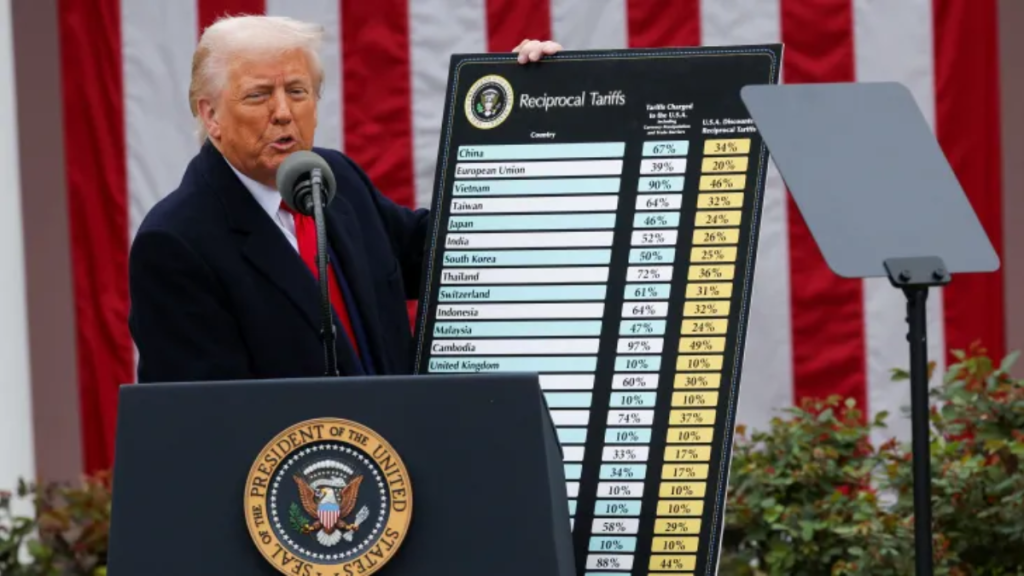In a groundbreaking development, the Trump administration’s tariffs have brought in a record-breaking $15 billion in revenue for April 2025. This surge, primarily driven by a 25% duty on imported steel and a new 10% universal tariff, has sparked a new wave of debates on the effectiveness and long-term implications of Trump’s trade policies.
The increase in customs revenue is seen as a significant milestone in the ongoing trade war and highlights the impact of the Trump administration’s tough stance on imports.
For many, this surge in revenue from tariffs signals the success of President Trump’s “America First” economic agenda, aimed at boosting U.S. manufacturing while reducing the trade deficit.
The high tariff revenue, however, comes with a set of challenges, from higher consumer prices to potential retaliatory tariffs from other nations.
Record Surge in Revenue From Tariffs
In April 2025, U.S. Customs and Border Protection (CBP) collected an unprecedented $15.4 billion in duties. This amount is a sharp increase from previous months, demonstrating the growing impact of Trump’s tariff measures on U.S. trade.
The revenue spike is largely attributed to a 25% tariff on imported steel, which has significantly affected global trade flows, particularly from China and other steel-exporting nations.
This surge also includes revenue from a broad 10% tariff imposed on various imported goods, a measure that took effect on April 2, 2025. While the full impact of the 10% tariff is expected to be more visible in May, the preliminary figures already show substantial contributions to the federal coffers.
The Economic Impact of the $15 Billion Surge
The $15 billion collected from tariffs in April sets a new record, positioning the U.S. to potentially generate over $180 billion in tariff revenue by the end of 2025.
This would be the highest amount collected in a single year from customs duties since the 1930s, marking a dramatic shift in how trade policy is structured in the United States.
Economists have projected that Trump’s tariff policies could result in even larger sums in the coming months. According to the Peterson Institute for International Economics (PIIE), the revenue from the tariffs could contribute up to $3.9 trillion in federal revenue over the next decade, assuming no major retaliatory actions from foreign governments.
While these numbers reflect a substantial influx of revenue, critics argue that the long-term economic effects could undermine these gains.
Trump’s Tariff Policies and Potential to Replace Income Taxes
President Trump has been vocal about his belief that the revenue from tariffs could eventually replace income taxes. In an interview in mid-April 2025, he stated, “There’s a real chance that the money from tariffs could be so great that it would replace the income tax.”
This bold statement has sparked debate among economists and policymakers about the feasibility of such an idea.
Supporters of Trump’s tariff policies argue that they could reduce the financial burden on American taxpayers and lessen the reliance on income taxes, which many see as an inefficient form of revenue generation.
However, critics argue that tariffs could lead to unintended economic consequences, such as higher prices for goods, especially in industries reliant on imports.
The Drawbacks of Tariffs: Consumer Prices and Retaliation
While the $15 billion revenue surge is a positive sign for the federal budget, the broader economic impact remains mixed. The tariffs have resulted in increased costs for many goods, from steel to everyday consumer products.
Major corporations, including Procter & Gamble and PepsiCo, have already warned of price hikes on products ranging from household items to beverages, as they face higher costs for raw materials.
Furthermore, the imposition of tariffs has led to retaliatory measures from trading partners. China, the European Union, and other countries have already enacted tariffs on U.S. exports, affecting sectors like agriculture, automotive, and technology.
These retaliatory tariffs could potentially hurt U.S. manufacturers and reduce the effectiveness of Trump’s trade policies, especially if they lead to a drop in exports.
The Impact on U.S. Industries and Global Trade
The increased tariffs have had a significant effect on industries that rely on global supply chains. For instance, the steel industry has seen both positive and negative effects. While U.S. steel producers benefit from reduced competition, manufacturers that rely on imported steel have faced higher production costs.
This has led to concerns over job losses in certain sectors, as companies may be forced to scale back or relocate operations overseas to avoid the impact of high tariffs.
In addition to steel, the tariffs have also disrupted industries such as electronics and automobiles. With U.S. companies facing higher costs for components and raw materials, many are concerned about the long-term sustainability of the tariff strategy.

Can Tariffs Replace Income Taxes? Experts Weigh In
Economists are divided on the feasibility of replacing income taxes with tariff revenue. While tariffs provide a short-term boost to government revenue, they are not considered a reliable long-term solution. The reason? Tariff revenue is highly susceptible to changes in global trade dynamics.
If countries retaliate with their own tariffs, or if the U.S. faces a global recession, the revenue from tariffs could diminish significantly.
Moreover, as tariffs raise the cost of imported goods, they could also reduce consumer spending, which is a key driver of the U.S. economy. This potential reduction in consumption could offset the gains from tariff revenue, especially if consumer confidence drops or unemployment rises due to the higher cost of living.
Conclusion: A Controversial but Revenue-Boosting Strategy
Trump’s tariff policies have undoubtedly created a new economic reality, with the $15 billion revenue surge in April 2025 marking a major milestone in his “America First” agenda.
While the immediate effects have been positive in terms of federal revenue generation, the long-term consequences of these tariffs remain uncertain. The possibility of tariffs replacing income taxes remains a controversial topic, with many economists cautioning against such a radical shift.
As the U.S. moves forward with these policies, it will be crucial to monitor the broader economic impacts, including potential price hikes, job losses, and retaliation from other countries.
Whether or not Trump’s tariff strategy will stand the test of time remains to be seen, but one thing is clear: the U.S. government is rethinking how to generate revenue, and tariffs are playing a pivotal role in that transformation.
For more information on the U.S. tariff revenue surge and its impact on the economy, visit Investopedia and Washington Post.
Disclaimer – Our team has carefully fact-checked this article to make sure it’s accurate and free from any misinformation. We’re dedicated to keeping our content honest and reliable for our readers.
